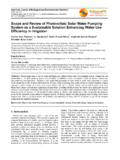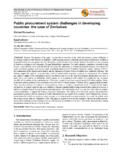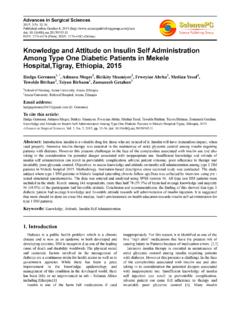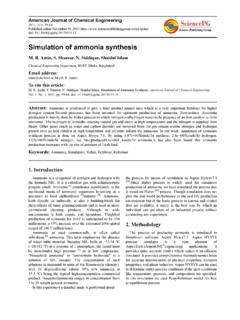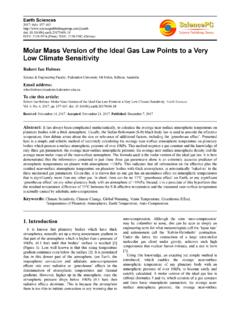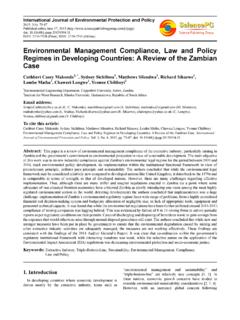Transcription of Design and Construction of a 2.5 Kva Photovoltaic …
1 American Journal of Science, Engineering and Technology 2016; 1(1): 7-12 doi: Design and Construction of a Kva Photovoltaic Inverter Ekwuribe J. Michael, Uchegbu E. Chinenye Department of Electrical and Electronic Engineering Technology, Abia State Polytechnic, Aba, Nigeria Email address: (Ekwuribe J. M.), (Uchegbu E. C.) To cite this article: Ekwuribe J. Michael, Uchegbu E. Chinenye. Design and Construction of a Kva Photovoltaic Inverter. American Journal of Science, Engineering and Technology. Vol. 1, No. 1, 2016, pp. 7-12. doi: Received: October 4, 2016; Accepted: November 2, 2016; Published: December 21, 2016 Abstract: The epileptic nature of power generation via hydro and thermal sources in Nigeria has given rise to source alternate forms of power generation. The power supply situation is so erratic that some communities are cut off for days, weeks, or months in a bid to ration the low supply from the nation s grid.
2 This gap, period of no supply or cut off from the grid, is what this paper will solve by way of designing and constructing an alternate source using solar power for household use. The Design and Construction of the unit, a solar powered inverter was achieved by using a 21/400 turns wound transformer, an SG3524N PMW fixed frequency voltage regulator controller, MOSFET transistors, five80W/18 Asolar panel, three200AH deep cycle battery, and a charge controller to monitor the output of the battery for safety. The battery is connected to the inverter circuit to generate 220V alternating current in its output via a step-up transformer. The inverter uses the SG 3524N IC chip fixed frequency Pulse Width-Modulator (PMW) Voltage regulator controller. The designed oscillation period is set at 50% duty cycle or seconds to match the frequency of loads connected to it.
3 From table of results; the inverter was able to maintain stability for 4 hours when a refrigerator and other loads up to a 2000W were connected to it. But at peak sunshine and the solar panel tilted 0o relative to the roof inclination, the inverter output for the same load lasted longer hours. Keywords: KVA, PWM, SG3524N, MOSFET, Photovoltaic , Power Factor 1. Introduction Photovoltaic inverters are inverters either used for day system only or for day and night periods [1]. The later describe the ones that have battery backup for use when the sun is down or cloudy. The simplest and least expensive Photovoltaic system is the day use and consists of module wired directly to an appliance with no storage device. When sun shines on the modules, the appliance consumes the electricity generated. Higher isolation (sunshine) levels results in increased power output and greater load capacity.
4 Hybrid describes system with battery storage. The battery backs up power to the inverter connected to it during periods of less isolation and at night. The battery is usually charged during sunny period with PV modules or alternate source to keep it ready for use during the night. Another hybrid system approach is a PV system integrated with a wind turbine. Adding a wind turbine make sense in the location where the wind blows when the sun doesn t shine. In this case, consecutive days of cloudy weather are not a problem so long as the wind turbine is spinning [2], [5] and [6]. These forms of inverters are available in the market to drive light loads in the range of 500 to 1000watts. Higher wattages are realizable by calculating a household total electrical load and sizing the entire system (inverter, PV array and battery) to meet such loads.
5 It is this aspect that roused our Design and Construction interest. Sizing the Entire System Many methods exist for sizing a system output for optimum performance. One method makes use of solar calculator where all electrical loads are manually calculated and uploaded to the calculator for sizing. Alternatively, data of energy consumption provided by an electric utility company [like Enugu Electricity Distribution Company (EEDC) electric bill] can be uploaded for sizing. Manual sizing as used in this Design is also possible. This is achieved by use of worksheet to calculate loads for consumption. The format followed is listed below [1]: List all of the electrical appliances to be powered by the system. Record the operating wattage of each item following the 8 Ekwuribe J. Michael and Uchegbu E. Chinenye: Design and Construction of a Kva Photovoltaic Inverter previous step.
6 Specify the numbers of hours per day each item may be used. Multiply the first three columns to determine watt hour usage per day. Enter the number of days per week that each item will be used to determine the total watt hour per week each item will require. For equipment ratings, check the label of equipment and record their values accordingly, otherwise check with local appliance dealers or product manufacturers for information. Relivance of Project The major problem solved by this Design is regularity of electricity supply at all times, as the battery will be constantly charged during day periods without affecting the integrity of the battery during night periods when it will be used as an alternate source if supply from the national grid fails. 2. Method Sizing of the PV panel is critical to the overall efficiency of the entire system.
7 The inverter sizing is application-specific and depends on manufacturer guidelines, available inverter sizes in the market and country s climates and regulations (in compliance with grid codes) [8]. The PV inverters are also sized based on the minimum power factor when delivering rated active power of the PV arrays [8]. A calculation that makes use of sizing worksheet was followed with the following load information keyed in for sizing. Electrical Load Information We made use of 2090watts energy consumption for a particular household as average over a six months period. The loads include one washing machine, one TV set, a DVD player, one refrigerator, one blender, bread toaster, electric iron, three fans and thirteen pieces of energy saver lamps, which usage are determined according to time of need.
8 Table 1. Load estimation worksheet. Individual Loads Qty X volts X Amps = Watts X Use X Use 7 = Watt Hours AC DC Hrs/day Days/wk Days AC DC Washing machine 1 220 330 - 2 3 7 283 - TV 1 220 110 - 4 7 7 440 - DVD player 1 220 110 - 4 7 7 440 - Refrigerator 1 220 220 - 7 7 7 1540 - Blender 1 220 330 - 2 7 - Bread toaster 1 220 330 - 3 7 - Electric iron 1 220 550 - 3 7 118 - Energy saver lamp 13 220 110 - 7 7 550 - AC Total Connected Watts: 2090 AC Average Daily load: 3488 DC Total Connected Watts: _____ DC Average Daily Load:_____ Table 2. Battery sizing worksheet AC Average Daily Load (w-hr/day) Inverter efficiency + DC Average Daily Load (w-hr/day) DC System Voltage = Average Amp hours/Day [(3488 ) + 0] 48 = Average Amp-hours/day X Days of autonomy Discharge limit Battery AH Capacity = Batteries in parallel X 4 200 = 3 Table 3.
9 Array sizing worksheet. Average Amp-hrs/day Battery efficiency Peak sun Hrs/day = Array peak Amps = 25 Array peak amps Peak Amps/module = Modules in parallel Modules Short Circuit Current 25 = 5 Table 4. Controller sizing worksheet. Modules Short Circuit Current X Modules in parallel X = Array short circuit Amps Controller Array Amps Listed Desired Features X 5 X = 30A American Journal of Science, Engineering and Technology 2016; 1(1): 7-12 9 Table 5. Inverter Sizing Worksheet. AC Total Connected Watts DC System Voltage Estimated Surge Watts Listed Desired Features 2090 12 6270 Analysis of Worksheets Inverter Sizing: From the inverter sizing worksheet, the estimated calculated maximum load was 2090W; the system estimated surge watt which is normally three times of the AC connected loads was calculated to be 6270W.
10 Given these parameters, room was made for sudden addition of load(s); hence a unit was designed and constructed to meet these needs. The inverter will receive DC power from the battery, and convert it to usable DC and AC outputs. All other subsystems receive information from the output of the power inverter. As such, the inverter is critical to the integrity of the entire system. Safety concerns must be at the forefront of the circuit Design [4], [2]. These concerns stem to the safety of the users, as well as the circuitry itself. We recognized this issue, and accounted for it with a properly placed circuit breaker. The circuit was designed so that if a power spike occurred, or something malfunctioned, the key components of the system would be saved, as the breaker opens.
